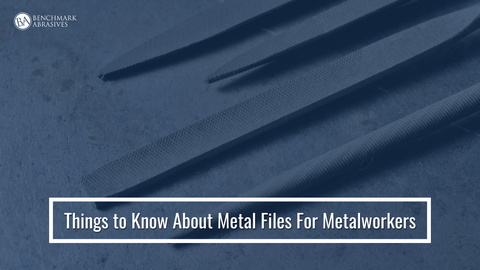
Things to Know About Metal Files For Metalworkers

Metal files are essential tools for any metalworker, from professional machinists to hobbyists. Each type of file is made for a specific function and is used to shape, polish, and finish metal. While the variety can be overwhelming, knowing the common types will help you choose the right tool for the job.
This blog post will cover the most important types of metal files and their applications.
Understanding the Basics
Metal files are categorized by their shape, cut (the pattern of the teeth), and coarseness. Whether it's delicate finishing or aggressive material removal, each combination is designed for a specific use.
Common Metal File Shapes
1. Flat File
This is the most fundamental file for any beginner. It has a flat, rectangular shape and is used for smoothing and shaping large, flat metal surfaces. It's also perfect for truing up edges and creating a clean, straight finish on a workpiece.
2. Half-Round File
The half round file has one edge rounded and the other flat. Its dual-purpose design makes it highly adaptable. The rounded edge is ideal for shaping and smoothing the inner curves of ring shanks, hoops, or any concave surface, while the flat edge is used for flat surfaces.
3. Crossing File
Similar to a half-round file, a crossing file has two curved sides, each with a different radius. One side has a taller dome, making it ideal for creating different sized curves and convex shapes. The tapered shape allows you to work on both large concave surfaces and narrower areas.
4. Barrette File
A barrette file is unique because its cutting teeth are only on one flat surface. The other side is smooth and tapered. This design makes it perfect for working on precise, detailed areas. You can file right up to a finished surface without worrying about damaging it with the smooth, non-cutting side.
5. Needle Files
Needle files are a set of small, fine files used for precision work and finishing. They are essential for a metalworker's toolkit and are typically sold in sets containing various shapes.
- Flat/Pillar: A versatile file for smoothing surfaces and straightening wire ends.
- Square: Used for filing at a 90-degree angle into corners and creating square holes.
- Triangular: Perfect for filing into corners, creating grooves, or making a small notch in a piece of metal.
- Round: Ideal for working on small, curved spaces like jump rings or the inside of a clasp.
How to Use a Metal File
- Secure Your Work: Always secure your workpiece in a vise or clamp to prevent it from moving while you work.
- Use the Right File: Choose the right file for the job. A coarse-cut file is best for aggressive material removal, while a fine-cut file is for smoothing and finishing.
- Steady Strokes: Apply even pressure and use smooth, steady strokes in a single direction to file. Pushing and pulling the file can dull the teeth.
- Clean Your File: Regularly clean the teeth of your file with a wire brush or "file card" to remove metal filings and keep it working efficiently.
By understanding the different types of cutting tool files and their specific uses, you can work more efficiently and achieve a higher-quality finish on all of your metalworking projects.



































































